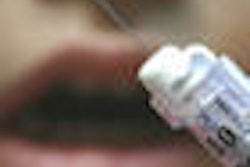
BOSTON - Resorting to sedation every time an autistic patient needs a dental exam is unsafe -- and unnecessary, May-Lynn Andresen, R.N., the administrative director of the Fay J. Lindner Center for Autism and Developmental Disorders in New York, told a roomful of dental professionals at the Yankee Dental Congress on Thursday. "If you can get them to sit in the chair and open their mouths, the rest will come."
Andresen explained how dentists can gradually gain autistic patients' trust and deal with seemingly rude or baffling actions. "So often, their behaviors are misinterpreted," she said.
People suffering from autism have severe trouble communicating and socializing with others. The developmental disorder now affects about 1 in every 150 people, up from 1 in 500 just a decade ago, Andresen said. While no one can explain the rise in this condition, the increase means that more and more general dentists are encountering autistic patients in their offices.
By understanding the basics of autism and having lots of patience, dentists can give these disabled people the oral care they so desperately need, Andresen emphasized. With some autistic patients avoiding dentists for years -- perhaps decades -- at a stretch, many have mouths full of cavities when they finally make it to the office.
One key to treating an autistic patient is to work slowly, Andresen noted. "When you think you're going slower, then slow it down more."
Often, these patients need to come in repeatedly for short visits -- once, perhaps, just to sit in the waiting room, another time to get used to sitting in the dental chair. It's important to end a visit if the patient is starting to become stressed and offer praise for what was accomplished, Andresen said. Autistic people tend to have excellent memories, so they will vividly remember negative experiences.
For autistic patients, the dental office environment is critical, she said. First, it's important not to keep the autistic patient waiting. For some, waiting is the hardest part of the visit, Andresen said.
These patients respond best to calm voices. They need to see -- and be comfortable -- with every piece of equipment the dentist is going to use, she added. Some may be bothered by bright lights, so dentists might want to consider turning off the overheads and working with smaller lights in the mouth instead.
Autistic people often are comforted by blankets or something heavy -- such as a lead apron -- on their bodies.
These patients do not show anxiety like others do, Andresen said. Instead of looking at their patients' faces for clues to how they are feeling, dentists need to consider other cues, such as rubbing a body part or repeating certain phrases.
Many dentists also find it helpful to talk to a caregiver before the appointment to understand how the patient shows fear and what triggers anxiety.
But talking to the patient directly -- and correctly -- is critical, Andresen emphasized. Broad questions can be easily misinterpreted; for example, asking "What brings you here today" could easily elicit a response of "It's appointment day" rather than an explanation of how the patient is feeling.
In the long run, helping these patients overcome their fear is an important part of caring for them, Andresen said, because going to the dentist is a life skill they will need forever. "It's just as important as toilet training and learning to dress yourself," she said.
Copyright © 2009 DrBicuspid.com



















